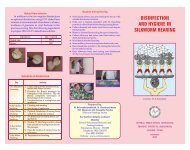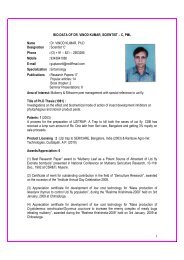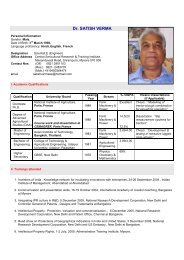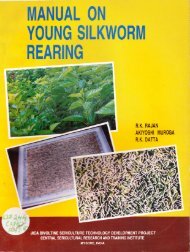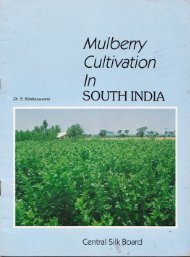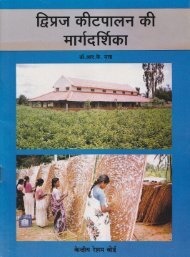ffiffi
Sericulture Practices for Hilly Areas of South India - Central ...
Sericulture Practices for Hilly Areas of South India - Central ...
- No tags were found...
Create successful ePaper yourself
Turn your PDF publications into a flip-book with our unique Google optimized e-Paper software.
;':Jil:l<br />
r::!l-.:lli'l<br />
l$,iiiliii<br />
tiri:il$<br />
i .i'':<br />
: li ::,.!.r.:.ij:r:<br />
..lall:i]l.iM<br />
<strong>ffiffi</strong><br />
'., : *s
Sericulture Practices for the<br />
Hilly Areas of South lndia<br />
- Dr. M.N. Narasimhanna, Director, National silkworm seed project, Bangalore.<br />
H.M, Kanyadi, Deputy<br />
-<br />
Director, Department of Sericulture, Government of Karnataka,<br />
Hassan.<br />
Dr. C. Ravikumar,<br />
-<br />
Scientific Officer, Karnataka State Sericulture Development lnstitute,<br />
Bangalore.<br />
H.K. Basavaraju, Senior Research Officer, National Silkworm Seed Project, Bangalore.<br />
-<br />
CENTRAL SILK BOARD<br />
(Ministry of Textiles Government of lndia)<br />
-<br />
United Mansions, 39, M.G. Road, BANGALORE-560 001.
FOREWORD<br />
Ll<br />
ITHERTO there has not been much of sericulture development in the hilly areas. Normally<br />
I I in the hilly areas of South lndia, coffee, tea, cardamom and other plantation crops are<br />
grown besides paddy in the valleys. But in other countries like China, the hilly areas with mild<br />
climate and high rainfall have sericulture as an important subsidiary activity. One of the<br />
break{hrough which is to happen still in the lndian sericulture is production of bivoltine in a<br />
significant way. At present out of the total production of about 8000 tonnes of raw silk, hardly<br />
100 tonnes is bivoltine raw silk though in the cocoon production the percentage will be higher<br />
because of bivoltine seed cocoon production.<br />
Bivoltine silkworms require better quality of mulberry leaf and appropriate rearing practices.<br />
The hilly areas of South lndia, especially the entire Weste?Ghat belt, has rainfall starting f rom<br />
200" tapering lo 25" and in the high lands mulberry grows extremely well. Once the basic<br />
nutritious leaf is assured, by following the correct rearing practices and maintaining cleanliness<br />
in the rearing room, very high yields of bivoltine cocoons can be obtained. There are<br />
farmers in the hilly areas of Hassan in Karnataka, Nilgiris in Tamil Nadu and ldukki in Kerala<br />
who have consistently obtained an average yield of 55 kgs. per one hundred silkworm laying<br />
which is comparable to the Japanese standards. The cocoons so obtained are also of high<br />
quality and in one kilogram there are often only as few as 400 cocoons giving a single cocoon<br />
weight of 2.5 gms. which at the rearers level is remarkable.<br />
However, the sericulture practices required in the hilly areas are slightly different f rom those<br />
in the plains. This is because of fairly higher rainfall, milder climate and cold weather during<br />
some months. The authors of this brochure have gone into the details and have prepared<br />
succinctly useful recommendations. This has been prepared after visiting various farms in the<br />
hilly areas. This will be of immense use to the farmers and planters in the hilly areas of South<br />
lndia.<br />
u[t'<br />
(v. BALASUBRAMANTAN)<br />
MEMBER-SECRETARY
CONTENTS<br />
CHAPTER<br />
Page<br />
I<br />
ll<br />
lll<br />
lV<br />
V<br />
Vl<br />
lntroduction<br />
Mulberry Cuttivation<br />
a) Establishment of Mutberry Garden<br />
b) Culturat Operations<br />
c) Management of Murberry Garden from second year onwards<br />
(i) Pruning<br />
(ii) Training of Mutberry<br />
Plant Protection Measures for Mulberry<br />
a) Diseases<br />
b) Pests of Mutberry<br />
Silkworm Rearing in the Hilly Areas<br />
a) Rearing House<br />
b) Chawki Rearing House<br />
c) Late-age Silkworm Rearing House.<br />
d) Rearing Equipments<br />
Rearing ol Chawki Silkworms<br />
a) Disinfection<br />
b) Brushing<br />
c) Environment<br />
d) Leaf<br />
e) Spacing<br />
f) Bed Cleaning<br />
g) Care at Moutt<br />
h) Second Stage Silkworm Rearing<br />
Late-age Silkworm Rearing<br />
a) Disinfection<br />
b) Rearing Environment<br />
c) Quality of Leaf<br />
d) Spacing<br />
e) Leaf Quantity<br />
f) Spinning<br />
g) Harvesting of Cocoons.<br />
11<br />
13<br />
23
Vll. Silkworm Diseases and Sericulture Hygiene<br />
2s<br />
Vlll. The Hilly Areas Hold the Promise of Bivoltine Silk Production s0
SERICULTURE PRACTICES IN THE HILLY AREAS OF SOUTH INDIA<br />
lntroduction<br />
The l-tilly areas of South lndia enjoy salubrious climate for rearing high yielding varietiesof<br />
silkworms and are ideally suited for rich bivoltine cocoon harvest from which superior quality<br />
of silk can be produced. Manyof thefarmers in Hassan, Chikmagalur, Shimoga, Sirsi, Belgaum<br />
in Karnataka, Nilgiri ranges in Tamil Nadu and ldukki in Kerala have successfully taken up<br />
sericulture by adopting improved technologies suiting to the eco-climatic conditi-ons. Sericullure<br />
is found to b'e an ideally suited avocation even for those who have taken to plantation crops<br />
in these areas. Mulberry cultivation has been taken as'monocrop' or'monoculture' in the fallow<br />
land of the plantations and is providing an attractive additional income for the plantation<br />
owners. This has also helped in engaging and reorienting plantation labour for rich economic<br />
returns.<br />
The Hillyareas ol south lndiaare generallyconcentratedon theWesternGhats of Karnataka,<br />
Kerala and Nilgiri ranges of Tamil Nadu. The altitude of these areas ranges between 2,500'to<br />
4,000' M.S.L. and the areas enjoy favourable climate for silkworm rearing, except during the<br />
heavy rainy season i.e., June-July. The fertile forest, soil, abundant water and good sunshine<br />
ensure luxuriant growth of mulberry. These areas generally, experience annual rainfall ranging<br />
between '1,000 to 2,500 mm. However, major portion of the rainfall is generally during June to<br />
August which provides sufficient water, to the ponds and wells required forgood growth of the<br />
crops round the year. Even though most of the land owners have taken up plantation crops<br />
such as coffee, tea, cardamom, pepper etc., they have also taken to sericulture considering its<br />
profitability.<br />
Plantation owners, especially, with small acreage have taken up sericulture as a subsidiary<br />
occupation to augment their income. These farmers have huge well-ventilated and isolated<br />
houses. Such houses are ideally suited for the good growth of silkworms as they provide<br />
proper environment.<br />
Central Silk Board, which has the primary responsibility to propagate, develop and nurture<br />
sericulture and silk production in the country, has felt that these,the hilly areas,can be<br />
fully exploited for raising rich Bivoltine cocoons and thereby take to production of inter -<br />
national grade silk. Technologies adoptable for mulberry cultivation and silkworm rearing in<br />
the hillyareas for bivoltine cocoon production are discussed in detail in this brochure.<br />
ll. Mulberry Cultivation<br />
The agro-climatic conditions and slightly acidic soils available in the hilly areas are advantageous<br />
for good growth of mulberry. The soil in the hilly areas is rich due to forest and<br />
has high moisture retaining capacity which are ideal for cultivation of high yielding varieties of<br />
mulberry viz., Kanva-2 (M-5) and S-54. These varieties favourably respond to the inputs<br />
and cultural practices and thereby yield about 600/o more leaf over the local variety. ln<br />
addition, these varieties produce nutritious leaves which can also retain moisture for a longer<br />
period.<br />
a) Establishment ol Mulberry Garden<br />
Mulberry can be planted in slopes of hilly areas which are are not prone to water logging. ln
slightly slopy lands it is necessary to dig deep trenches around mulberry plantation to provide<br />
proper drainage. wherever mulberry is planted in marginal slope lands, contour bunding is<br />
provided to check soil erosion.<br />
L<br />
_l<br />
_J<br />
_l<br />
1l;;<br />
lP, -l<br />
L<br />
_i<br />
_l<br />
FN<br />
.r +-JL_ -l<br />
Fig. 1. Pit System (3'x 3')<br />
t'<br />
.)<br />
B'<br />
Fig.2. pit showing planting method.<br />
June-July months are suited for planting mulberry in hilly areas, as the monsoon rains help<br />
for sprouting and rooting.of mulberry. Pit system of planting is suited for these areas, having a<br />
sizel'x1'x1'whicharedugatadistanceof3'x3'.Thepitsirefitteowitnamixtureoffarmyard<br />
manure, red earth and soil (tig.2). Planting material is taken from m ulberry shoots, wh ich are of<br />
9 to 12 months old. shoots having pencit inlctness are cut to 9" length and should have about<br />
4-5 live buds for planting. Two to three cuttings are planted at g" deepth in pits in such a way<br />
that one or two buds are exposed outside the pit. This method helps in establishment of roots<br />
2
deep in the soil as also for easy sprouting. ln order to avoid ptagnation of water, it is suggested<br />
to raise the soil as heap around the cuttings. Whenever there is less rain, the plants should be<br />
watered once a week.<br />
SOI L<br />
FYM +50t1<br />
It is advantageous to raise mulberry plantations by raising saplings in nurseries separately<br />
during the month of March. Nursery beds are prepared with sand and rich farmyard manure.<br />
The cuttings which are 9" in length are planted 4" lo 6" apart (fig. 3). These nursery beds are<br />
Fig. 3. Nursery Bed
properly watered at least once in three days. When cuttings are planted in the nursery in March,<br />
the saplings attain a height of about 11/zleet by June, which are ideal for transplantation.<br />
Fig. 4. Polythene bag nursery<br />
Mulberry saplings can also be raised in polythene bags. Polythene bags ol9" x 4" sizeand<br />
150 gauge with holes on the bottom half , are f illed with a mixture of farmyard manure, sand and<br />
red earth (fig. 4). Mulberry cuttings of 9" length are planted exposing 2 live buds to light. These<br />
polythene saplings are regularly watered. After three months, the saplings can be transplanted<br />
by removing the cover. Planting saplings from polythene tubes helps in avoiding injury during<br />
transplantation.<br />
After a month of planting, it will be possible to locate pitfailures and promptaction should be<br />
taken for gap filling with saplings raised in nursery.<br />
Raising 3' x 3' pit system of mulberry plantation helps in better up-take of NPK and other<br />
minerals. This also provides copious sunlight for quick and rich growth of mulberry.<br />
b) Cultural Operations<br />
ln hill areas, because of continuous rain, weeds grow fast. Even then, it is advisable to take up<br />
weeding of mulberry plots after 3 months of plantingand to allow good rooting of mulberry<br />
plants undisturbed. During the first year it is always advisable to take up inter-cultivation by<br />
using manual labour, as the use of bullock power may destroy the establishing plants.<br />
Mulberry requires only one fourth of water required for paddy cultivation. Further, the rich<br />
soils of hill areas hold water for long duration. lrrigation for mulberry should be controlled and<br />
need not be as f requent as in plains. However, farmer can decide by experience and by looking<br />
to the mulberry plants, the need for irrigation. Generally, mulberry needs irrigation once in 10<br />
to 15 days.<br />
After 3 months of plantation, half a bag of urea may be applied as booster dose. This<br />
application should be do4e by preparing 3 holes of S" depth and about 6" awayfrom the plants<br />
4
(fig. 5). A tea spoon f ull of urea is applied foreach hole and closed immediately. During the first<br />
year, 3 split doses of fertiliser are applied at least one month earlier to each leaf harvest. The f irst<br />
dose of fertiliser can be 20 kg. N : 10 kg. P : 10 kg. K;second dose of 20 kg. N and the third dose<br />
of 20 kg. N : 10 kg. P : 10 kg. K per acre. The f irst dose of complex fertiliser is applied on the 5th<br />
month of plantation, so that it ensures rich growth of leaf for rearing silkworms by the sixth<br />
month.<br />
Fig. 5. Application of Fertilizer.<br />
The leaf can be harvested for silkworm rearing after six months of planting. Second harvest<br />
of leaf can be taken in nine months and 3rd harvest on the 11th or 12th month of planting.<br />
During the f irst year, the total quantity of leaf available is about 4,000 to 5,000 kgs/acre. This will<br />
enabte rearing of 75 to 100 df ls of bivoltine silkworm for the f irst crop, 150 to 175 dfls for the<br />
second crop and 175 to 200 dflsforthethird crop. Leavesforrearing silkwormsareto be picked<br />
in the cool hours of the day, either 8 a.m. to 9 a.m. or after 4 p.m. in the evening. Leaves are<br />
transported in baskets covered with wet gunny cloth (fig. 6).<br />
c) Management of Mulberry Garden lrom Second Year Onwaros<br />
(i) Pruning<br />
Generally, the hilly areas experience heavy rainfall during the months of June-July-August
(ii) Training ol Mulberry<br />
During the 3rd year, the plants are pruned 6" above the previous cut so as to allow four to five<br />
branches (fig. 8). Such a system will help in training the plant as low cut bushes. This helps in<br />
proper aeration and prevent soiling of bottom leaves during rainy season<br />
WeecJing is carried out soonafter the pruning and at least thrice ayear.Wherever availability<br />
of manual labour is difficult, ploughing by use of bullocks can be adopted. Horsegram may be<br />
planted between plants to enrich the soil, and to control weeds. Picking of mulberry leaves for<br />
rearing may be canied out even by a stamping of horsegram. After six months when horsegram<br />
starts flowering, they may be ploughed back in to the soil. Dhaincha seeds can also be<br />
tried as green manure. Such practices, maintain fertility and richness of the soil.<br />
Ten tonnesfarmyard manure can be appliedper acre per annum in the month of<br />
January. Ten cart loads of red earth or tank silt can also be applied alongwith farmyard manure<br />
every year.<br />
Fertiliser dosage suggested for mulberry in hilly areas is 100 kg. N :40 kg. P:40 kg. K peracre<br />
in five split doses corresponding to 5 leaf harvests. Fertilisers are generally applied by making<br />
three holes around the plants to a depth of about 8".<br />
During the 2nd year, about 7,000 to 8,000 kgs of leaf can be harvested from one acre of<br />
mulberry plantation. This is sufficient to rear about 800 bivoltine dfls in 4-5 crops a year. From<br />
3rd year onwards, 10,000 12,000 kgs of leaf can be harvested per acre which is<br />
-<br />
sufficient to<br />
rear about 1,000 bivoltine dfls (fig. 9).<br />
Fig. 9. Mulberry Garden
These are some of the general guidelines suggested, which may be modified to suit a<br />
particular ecological conditions of the area. The calender of operations for mulberry cultivation<br />
in hilly areas is as under:<br />
Table: Calender of events f or Mulberry cultivation in the hilly areas ol South lndia (Second year<br />
onwards)<br />
sr.<br />
No. Operations Scheduleg<br />
1. Annual base pruning (18"-24" low cut)<br />
2.<br />
3.<br />
4.<br />
5.<br />
6.<br />
7<br />
Weeding, intercultivation, preparation of<br />
ridges, furrows and drainage channels<br />
Sowing of horsegram seeds as green<br />
manure intercrop<br />
First dose of complex fertiliser<br />
(20 kg of nitrogen, 20 kg of phosphorous,<br />
20 kg of potassium)<br />
Second dose of fertiliser<br />
(20 kg of nitrogen only)<br />
3/4 week of June (After the commencement<br />
of South West mondoon rains)<br />
within a week after pruning<br />
1st week of July (within second week of<br />
prunning|3rd week of July<br />
(Within 4 weeks of pruning and 3-4 weeks<br />
before the next leaf harvest)<br />
First leaf harvest and silkworm rearing Mid August to 2nd week of september<br />
(Brush about 200 dfts)<br />
Cocoon harvest<br />
Mid September<br />
Late September (within 2 weeks afterthe last<br />
leaf harvest)<br />
8. Second leaf harvest and Silkworm rearing Mid October to 2nd week of November<br />
(brush about 190 dfts)<br />
L Cocoon harvest<br />
Mid November<br />
10. Weeding and mulching of Horsegram 3rd week of November<br />
plants into the soil<br />
11. sowing of other green manure seeds 4th week of November.<br />
(Dhaincha)<br />
12. Third dose of complex fertiliser 4th week of November.<br />
(20 kg of nitrogen, 20 kgs of phosphorus,<br />
20 kg of potassium)<br />
13. Third leaf harvest and silkworm rearing Mid December to Mid January (Brush<br />
about 180 dfts)<br />
14. Harvest of cocoons 2nd week of January<br />
'15. Middie pruning (About g" above the<br />
previous annual base pruning) .^<br />
2nd week of January.<br />
16' Application of FYM/compost (tKnnes / 3rd week of January (within a week after<br />
acre)<br />
middle pruning.)<br />
17 ' 4th dose of fertiliser application (20 kgs of 1st week of February (After 2nd week of<br />
nitrogen only)<br />
pruning)<br />
8
18. 4th leaf hanrest and silkworm rearing<br />
19.<br />
20.<br />
21.<br />
22.<br />
23.<br />
Cocoon harvest<br />
Weeding and mulching of the green<br />
manure plants into the soil<br />
Sth dose of lertiliser application (20 kgs<br />
of nitrogen only)<br />
Sth leaf harvest and silkworm rearing<br />
Cocoon harvest<br />
1st week of March to last week of March<br />
(Brush about 220 dfls)<br />
1st week of April<br />
2nd week of April<br />
2nd week of April<br />
1st week of May to lV week of May (Brush<br />
about 220 dfls)<br />
1st week of June.<br />
lll.<br />
a) Diseases<br />
Plant Protection Measures for Mulberry<br />
Mulberry when grown in high humid conditions is prone to mainly two diseases,<br />
namely powdery mildew and leaf spot diseases (fig. 10). These are common during and just<br />
after rainy seasons in high altitude. When plants are raised at closer distance in the garden<br />
these disease attack mulberry severely, making the leaf unsuitable for silkworm rearing. Wider<br />
Fig. 10. Powdery Mitdew.
spacing helps in better aeration and reduce humidity. Even in such conditions, these two<br />
diseases may become rampant' Hence spraying or tungicioes, ru"n ".<br />
Dithane M-45 in o.2o/o or<br />
Bavistin of o'1o/o concentration to the leaves are effective. Leaves may oe fed to silkworms after<br />
15 days of spraying without any ill effects. spraying or tnese rungicides can be taken as a<br />
:"#ffjJ::autionarv measures during Jurv-Augusl o,, *n"n"*r the rainfail is heavy and<br />
Fig. 11. Hairy Caterpiilar<br />
l0
) Pests of Mulberry<br />
Agro-climatic conditions at high altitudesfavourthegrowth of lepidopterous insects. Generally,<br />
mulberry in these regions is attacked byfiiacrisia obtica, the Bihar hairy cater pillar (fig.<br />
11)' The moth lays deep yellow eggs on the lower surface of mulberry leaves. These eggs hatch<br />
and the young cater pillars accumulate in groups on the lower surface of the leaf. The first<br />
symptom of the attack is, these caterpillars are seen alongwith reticulate leaf as the larvae eat<br />
away the chlorophyll when such primary infection is noticed immediately spraying of O.2o/o ol<br />
DDVP or Dimecron O.2o/o is suggested.<br />
Generally, grownup larvae of Diacrisia being poly phagus in habit, crawling in swarms to<br />
mulberry from neighbouring areas. The worms have black head with brownish bodyand black<br />
hairs. They are gregarious in habit and voracious eaters, so m uch so that plantation is den uded<br />
in a short span of time. O.2o/o DDVP or O.2o/o Dimecron can be sprayed. DDVP sprayed leaves<br />
can be fed to silkworms after 3 to 4 days of spray, while the one sprayed with dimecion can be<br />
fed after 15 days of spray.<br />
lV. Silkworm Rearing in the Hilly Areas<br />
The climatic conditions of these areas enjoy high humidity of 60 to 70 percent throughout<br />
the year which is ideal for rearing of bivoltine silkworms. This also helps in maintaining the<br />
DOOR<br />
DOOR<br />
Fig. 12. Ground plan of Chawki Rearing House<br />
l1
freshness of leaf for longer duration of rearing which enables the farmers to reduce numberof<br />
feedings to 3 to 4 per day instead of 4 to 5 feedings, generally practiced in plains.<br />
silkworm.rearing technology for hilly areas is discussed as under.<br />
a) Rearing House<br />
ln Hilly areas an acre of mulberry yield is sufficient for rearing 200 to 250 dfls at a time.<br />
Considering this factor, a small compact Chawki Silkworm Rearing house of 10'x g'and late<br />
age silkworm rearing house of 30' x 16'are suggested (fig. 12).<br />
b) Chawki Rearing House<br />
It is always advisable to select compact rearing house with proper windows and doors for<br />
maintaining higher temperature and humidity toi young-"g" Jiri*or1n ;;ng. ;nJlia*ri<br />
silkworrn rearing house should have only one entrance tJauiioi&uent visit of workers and to<br />
maintain hygiene and required temperature and humidity conditions. Two Chawki rearing<br />
stands and trays can be arranged on one side during rearing. roi easy handling about 10 - 12<br />
rearing trays are arranged on one stand. The otherstlno can-ue used for piling upatthetimeof<br />
feeding and during moult.<br />
tr-t<br />
"rl<br />
1<br />
10,<br />
rii-l<br />
bl<br />
DOO R<br />
Fig. 13. Late-age Rearing House (side view)<br />
12
c) Late-age Silkworm Rearing House.<br />
Rearing house should be oriented in east-west direction to avoid heating of rearing rooms<br />
due to direct sunlight' Size of the rearing house suggested is 30, length x 16,width ,. 10; height.<br />
It may be provided with roofing of asbistasor n-c.c. (tig. r 3j. The rearing house shourd be<br />
provided with two rows of ventilators. one row of three tJ four ventirators can be provided at<br />
about one-foot from the ground level and another row at seven foot from ground rever. This<br />
helps in cross-ventilation and m4intaining desired t"rp"i"irr" and humidity. The ventilators<br />
may be provided with glass doors to cl6se-and-open as ,eqriieo to regulate humidity and<br />
temperature during winter and summer months. Hence, it is suggested to construct a small leaf<br />
preservation room of 6'x 6'adjoining the rearing house. pr"."r-uliion of reaf covered with a wet<br />
gunny cloth in the rearing house will increase humidity. rne rear preservation room may be<br />
connected to the rearing house with a chute, so that teaictroppeJfor sirkworm rearing may be<br />
transferred easily' similarly, one more chute can be fixed ;ifl;or revel to sweep out waste<br />
material directly outside' For summer rearing, if the tempera;;is high, the roof of the rearing<br />
house may be covered with straw or coconut mats, which ,'n;; ;" kept moist. such practice<br />
reduces temperature in the rearing house. wherever<br />
"ro"rto.litiled<br />
roofing is available, it is<br />
suggested to have a ventilator or a chimney at roof lever, which enabres hot air to escape. lt is<br />
advisable to provide verandah around the rearing house to artow entry of coor air from outside<br />
and atso provide space for keeping chandrikesi"r,"g rn;"ii"g.<br />
d) Rearing Equipments<br />
Equipments required for rearing or 2so dfrs at a time are give berow:<br />
3.<br />
4.<br />
5.<br />
6.<br />
7.<br />
8.<br />
9.<br />
10.<br />
11.<br />
12.<br />
13.<br />
14.<br />
15.<br />
16.<br />
17.<br />
't8.<br />
19.<br />
20.<br />
21.<br />
22.<br />
23.<br />
1. Wooden chawki stand<br />
2. Wooden rearing trays<br />
tx4'x4"<br />
Hygro meter<br />
Feeding stand<br />
Cleaning nets<br />
Foot cleaning mats<br />
Ant wells<br />
Leaf chamber<br />
Bamboo round trays 4'diameter<br />
Rearing stands<br />
Leaf chopping board<br />
Leaf chopping knives<br />
Gdlor sprayer<br />
Bamboo mountages: 6'x 4'<br />
Plastic basins for feeding<br />
silkwonms 15" Dia. x 6" depth<br />
Foam pads 44" x 2" x 2"<br />
Foam pads 36" x 2" x 2"<br />
Chop sticks 8" tength<br />
Mats 6' x 3'<br />
Black papers 3'x 4'<br />
Paraltin paper-1 roll (3'x 100,)<br />
Feathers<br />
Plastic basin stand<br />
2 Nos<br />
12 Trays<br />
2 Nos<br />
2 Nos<br />
260 Nos<br />
2 Nos<br />
60 Nos<br />
2 Nos<br />
130 Nos<br />
13 Nos<br />
2 Nos<br />
2 Nos<br />
't No<br />
100 Nos<br />
2 Nos<br />
24 Nos<br />
24 Nos<br />
4 Nos<br />
2 Nos<br />
2 Nos<br />
One roll<br />
6 Nos<br />
2 Nos.<br />
r3
24.<br />
25.<br />
Formalin mats<br />
Room heaters<br />
2<br />
z<br />
Nos<br />
Nos<br />
V. Rearing of Chawki Silkworms<br />
- lrnportance of young age silkworm rearing has been fully realised by sericultural technologists<br />
both in lndia and abroad and it is considered to be the foundation for successfulcrops<br />
and harvest of good quality cocoons.<br />
Chawki silkworm rearing is a specialised job. Success of silkworm rearing and the quality of<br />
cocoons harvested later, depend on chawki rearing techniques adopted. proper young age<br />
silkworm rearing ensures uniform and quick growth of silkworms. Because.of proper carl and<br />
good growth of worms at early stages, they develop resistance to diseases at laterstages. The<br />
young age silkworm grow extremely fast. They require nutritious leaf, higher temperaiure and<br />
humiduty for their fast growth. Silkworms grow well at temperatu re ol25 lo Z7.C and g5o/o to<br />
900/o of humidity. ln hilly areas, the humidity is always high and temperature is tow. Hence,<br />
temperature for young age silkworms is required to be maintained.<br />
a) Disinfection<br />
Before the receipt of silkworm eggs for rearing, chawki room, rearing equipments etc. must<br />
be cleaned with water to remove dirt, remnants of dead larvae etc. Later, they are sprayed with<br />
bleaching powder solution. For this purpose, a kilogram of fresh bleaching powder L mixed<br />
with 5 buckets of water and sprayed on equipments and walls inside the rearing house. The<br />
next day the rearing house should be disinfected with 3olo formalin. 3olo formalin can be<br />
prepared from commercial formaldehyde by following the formula given below:-<br />
strength of commercial formaldehyde<br />
-<br />
Required strength of formalin<br />
Required strength of formalin<br />
= Number of parts of water to be added for one part of commercial formaldehyde.<br />
= that is, 38;-3-= 11.66 parts of water to be added to one part of commercial<br />
formaldehide to get 30/o formalin.<br />
The quantity of formalin required for spraying in the rearing house is calculated as follows:<br />
(a) Length x Breadth (Floor area)<br />
(b) Length x Height of each wall i.e., the'area of two walls.<br />
(c) Breadth<br />
" Height of each walls x 2. i.e.,,area of two other walls.<br />
(d) To this, add the area of the surface ceilling or in case of tiled-roof, the surface of the two<br />
slopes.<br />
(e) The total of these given areas required for disinfection.<br />
To disinfect 100 sq.ft. of space, about 800 cc of 3olo formalin is required. For chawki rearing<br />
house of above mentioned dimension, about 4.2 litres of 30/o formalin is required. Same<br />
quantity is required for disinfecting rearing equipments. Thus, totally, 8.4 litres of 3olo formalin<br />
solution is required for disinfection of chawki rearing house.<br />
Sprayingof formalinshouldbedonebetween'10a.m. andl2noonwhenthetemperatureis<br />
high. Before spraying, the doors and windows are closed and the crevices, if any, sealed. lt is<br />
14
not advisable to spray formalin during rain and early or later hours of the day. Generally, in hilly<br />
areas during rainy and winter seasons when the temperature is low, it is advisable to heat the<br />
room before spraying or adopt fumigation technique soon after spraying. Some formalin is<br />
allowed to evaporate over an oven with hot cinders and the room is totally closed. Care should<br />
be taken to keep that much of cinders to avoid fire hazards. Disinfection of rearing room is<br />
always done along with all the rearing appliances. The suitable time for disinfection is on 8th<br />
day of egg laying or at the'eye spot' stage of silkworm egg. The rearing house is opened the<br />
next day to allow residual fumes of formalin to escape. Afterwards the room is cleaned, the<br />
eggs are brought and kept for brushing.<br />
b) Brushing<br />
The eggs received from the grainages are spread in trays which are provided with paraffin<br />
papers for the base. About 6 egg sheets can be arranged in single layers in alray. Wet fodm<br />
strips are kept on all the sides and covered with black papers and paraff in papers. ln hilly areas,<br />
during rainy days when the humidity is higher than 800/0, there is no necessity of keeping wet<br />
foam pads. On the day of brushing, the paraffin paper and black paper are removed and<br />
immediately the egg sheets are distributed to the trays, at the rate of 25 dfls/tray. Later, these<br />
eggs are exposed to dim light which enable all the eggs to hatch uniformly. Generally, theyare<br />
exposed tc dim light at 8 a.m. in the morning to facilitate brushing between 9 to 10 a.m.<br />
Tender leaf is sprinkled over the hatched worms on the sheets. Worms are allowed to crawl<br />
for about an hour, and are tapped on to the tray. The left over worms, if any, on the sheet, are<br />
brushed with a feather.<br />
Now a days, the grainages have started supply of silkworm eggs in loose form. Loose eggs<br />
have an advantage over egg sheets in that all unfertilised eggs and dead eggs are removed<br />
during the preparation of loose eggs. This will enable only supply of fertilised eggs to the<br />
farmers. ln such cases where loose egg boxes are supplied, we can brush 50 dfls in one tray<br />
and spread the worms in two trays after first moult.<br />
ln the blue-egg stage the cloth of the loose egg boxes is torn and the eggs are kept in a tray<br />
with parafiin paper at the base. They are covered on all the four sides with foam pads and on the<br />
top with black paper and at bottom paraffin paper. On the day of brushing, the black paperand<br />
paraffin paper are removed and eggs are exposed to dim light for about 30 minutes. Mosquito<br />
curtain cloth of 10" sq is spread over the loose eEg boxes and good leaf is sprinkled overthe<br />
cloth to attract the worms to crawl on to the leaf . Later, worms along with the leaf on the net are<br />
shifted and the boxes with empty shells are removed (fig. i4).<br />
c) Environment<br />
The success of young age silkworm rearing depends on 3 major factors viz., (1) proper<br />
environment, (2) Proper quality of leaf and; (3) Spacing provided for silkworms, during their<br />
growth.<br />
J_<br />
(i) The optimum temperature for f irst-stage silkworms rearing is 26"do 28"C and humidity of<br />
850/0. Temperature above 30'C is harmful to silkworms. Si.milarly, temperature below 20'C<br />
affects physiology of the worms rendering them weak and susceptible to diseases. The rearing<br />
period is prolonged if the temperature is lower than 26'C.<br />
15
y';--..7 /-.:2.4<br />
)(<br />
1. Shoot let. 2.&3.Iagc.<br />
Fig. 15. Chawki Leaf.<br />
t7
1. I age. 2. II age. 3. III age. 4. Later ages.<br />
Fig. 15. Selection of Leaves for different ages.<br />
18
larvae and poor quality of cocoons at later stages. I<br />
faves for chawki silkworm rearing should<br />
be collected in the morning at 9 a.m. or in the evding after 4 p.m. Leaves are harvested in<br />
baskets covered with wet gunny cloth and transported to the leaf preservation room. They are<br />
preserved in leaf chamber covered with wet gunny cloth or in big earth$ vessels concealed in<br />
wet sand bed (fig. 16). This practice will help in preserving leaves in fresh state and retain its<br />
succulency for young silkworms. The leaves are cut to 0.5 sq.cm and fed to silkworms. Four<br />
feedings are given in a day at 6 a.m., 11 a.m.,4 p.m. and 9 p.m. When the atmospheric humidity<br />
is very high the moisture content in the leaf is also high as in the hilly areas during rainy<br />
seasons, we can feed 3 times a day viz.,6 a.m., 1 p.m. and 8 p.m. The size of the leaf for feeding<br />
at f irst stage should be increased from 0.5 sq.cm for brushing to 1 sq.cm on first day, 1 .5 sq.cm.<br />
on the 2nd and 3rd day. When the worms stari for settling for first moult the size of the leaf<br />
should be reduced to 1 sq.cm to enable drying of leaf.<br />
Fig. 16. Chawki Leaf preservation in Earthern Vessels<br />
19
e) Spacing<br />
ln case of brushing of silkworm,s f rom egg sheets about 25 dfls are brushed in a tray. The<br />
ideal spacing to be provided is i2" x 12" ai ine ti,',e ot orusning.<br />
It is always advisable to use chop sticks for providing spacing both at first and second instars,<br />
and not to touch the worms, as far as possible, by hand to avoid-contamination. The chop sticks<br />
can be washed in formalin and dried and kept for re_use<br />
"u"ryJ"y.<br />
The optimum spacing to be provided in each lray lor worms of 25 dfls of sheet eggs and 50<br />
dfls of loose eggs (one box) is given below:<br />
First lnstar<br />
1. At the time of brushing<br />
2. At the end of 24 hours<br />
3, At the end of 48 hours<br />
4. At the end of 72 hours<br />
25 dlls<br />
12" x 12"<br />
15" x 18"<br />
18" x 21"<br />
18" x 30"<br />
50 dfls<br />
(Loose eggs)<br />
24" x 24"<br />
30" x 36"<br />
36" x 42"<br />
36" x 48"<br />
The ideal method of increasing the spacing is to feed the silkworms on all sidesand sprinkle<br />
less leaves on the top, during the feeding time. This will enable the worms to crawl on all sides<br />
20<br />
Fig. .17. Chawki Rearing (Box rearing)<br />
1. Paraffin paper.<br />
2. Foam Rubber<br />
3. Rearing Tray (3, x 4,) 4. Chawki Stand.<br />
5. Ant well.
1.<br />
1<br />
Pueffin Paper. 2. Foain Rubber.<br />
and 2 to be removed during drying.<br />
Fig. 18. Criss-Cross arrangement of Trays'<br />
and spread uniformly in the bed. After each feeding, the pads are made wet; kept on allthe four<br />
sides and covered with paraffin paper. This helps in maintaining gptirfi'um humidity for the<br />
growth of silkworms "nd<br />
in retaining of the leaves freshness as far as possible. The wooden<br />
irdyr "r"<br />
piled up one over the other on the chawki stand, about 8 to 12 trays, depending on the<br />
convenience which can be arranged in one row (fig. 17). Before each feeding, the paraffin and<br />
foam pads are removed and trays are kept in criss-cross direction to facilitate free ventilation<br />
(f ig. 1g). This helps to dry the old leaf . This will also enable worms to crawl on to the surface and<br />
get ready to receive fresh leaf for the next feeding.<br />
l) Bed Cleaning<br />
Due to periodical feeding, the left-over leaves and faecal matters get accumulated.in the bed.<br />
Hence, cleaning of bed is necessary. During the f irst stage, we may give one cleaning after 60<br />
hou rs of brushing. However, it is advisable not to clean the bed at first stage, but attain the same<br />
objective by providing more space and loosening the bed. This is suggested, as the process of<br />
cleaning increases the loss of younger worms. For cleaning the bed, cotton nets of mesh size<br />
1 .S sq.cm are spread over the worms and f resh leaves are sprinkled. After about 20 minutes, the<br />
netsalongwith wormsaretransferredtoanothertrayandwasteleavesarethrownout. lncase,<br />
nets are not available, a layer of leaves along with worms are taken with a feather.<br />
g) Care at Moult<br />
As the worms grow, the body increases in size and to enable growth, the larva throws out its<br />
old skin. The process of throwing of old skin and developing new one is called'moulting'.<br />
Generally, the worms before settling for moult acquire shining body surface. The size of the<br />
21
head becomes small in relation to the body.and as compared to eating-worms or the worms<br />
which come out of moult (fig. 19). When the worms acquire this shining body surface the<br />
rearing bed hasto be spread loose to allow moisture to evaporate and driage of leaf. Size of the<br />
leaf fed to the silkworms should be reduced as the worms reach moult. When almost all the<br />
worms settle for moult, the paraffin paper and the foam pads are removed and the bed is<br />
loosened. when all the worms are setfled for moult, feeding should be stopped.<br />
It is necessary to sprinkle the lime powder which helps in drying of leaYes as well as prevent<br />
the incidence of diseases. For this purpose, powdered slacked lime is taken in a muslin cloth<br />
and sprinkled over the bed. This also will not allow newly moulted worms, if any, to feed left<br />
over leaves. Generally, it takes about 24 hours for the worms to come out of moult.<br />
Fig. '19. Larva just out of Moult<br />
22
Fig. 19. Larva at Moull<br />
h) Second Stage Silkworm Rearing<br />
Rearing of ll stage silkworm is much similar to that of rearing of first stage silkworms. After<br />
ensuring all the worms have come out of moult, the net of the size of 1 sq.cm. is spread over the<br />
rearing Oed and leaves are fed to silkworms. Allthe worms crawlthrough the net to eatthe fresh<br />
leaves. The net along with the leaves and worms transferred to another tray. ln case of loose<br />
eggs the worms are shifted to 2nd rearing tray. The 3rd, 4th and Sth leaves from the largest<br />
gl*ry leaves are ideally suited for rearing of second stage silkworms. The plucking of leaf and<br />
preservation of leaf is followed as in the first stage. The leaf should be cut to 1.5 sq.cm and fed<br />
for resuming feeding after f irst moult. The size of the cut leaves should be increased to 3 sq. cm.<br />
as the worms grow to the second moult. The spacing to be provided for second stage in each<br />
tray of 25 dfls is given below:<br />
Second lnstar:<br />
,<br />
'1. At the time of resuming the feeding after first moult.<br />
2. At the end of 24 Hrs.<br />
3. At the end of 48 Hrs,<br />
Area ol Bed<br />
18" x 30"<br />
30" x 36"<br />
36" x 48"<br />
Thetemperatureand humiditytobemaintainedforsecond-stagesilkwormsarebetween26o<br />
C to 28.C and humidity of 850/0. The quantum of leaf required for rearing the second-stage of<br />
sitkworm is estimated to be 6 to 8 Kgs for 100 DFLs. However, this can be changed depending<br />
upon the number of eggs per layings. Only one cleaning is suggested after 36 hours of<br />
resuming feeding.<br />
23
As in the case of first-stage, half-an-hour earlier to feeding, the paraffin and foam pads are<br />
removed and trays are kept in criss-cross direction. After feeding, the trays are piled up one<br />
over the other. Second-stage is the shortest among the other stages of larvae' The worms settle<br />
forsecondmoult, in21/zdaysafterfirst-moult.Duringthisstagealsothewormsacqulreshining<br />
nature and show all the symptoms of moult as in first-stage. When worms settle for 2nd moult,<br />
powdered slaked lime is sprinkled over the rearing bed as in first-moult. Generally, the worms<br />
take about 24 hours during the second-moult. Soon after resumption of feeding after 2nd<br />
moult the bed must be cleaned; worms can be transferred to round trays and can be shifted to<br />
late-age rearing house.<br />
Vl. Late-age Silkworm Rearing<br />
Late age rearing of silkworms require lower temperatures and humidity as compared to<br />
chawki worms. They require much more spacing than young worms. Soon after3rd moult bed<br />
cleaningi w,ith net is practiced everyday. (Fig.zt 1. Hence, late-age silkworm rearing house must<br />
be spacious to accomodate more number of stands and round bamboo trays and provided<br />
with cross ventilation to maintain cooler atmosphere. As suggested earlier it must be provided<br />
with alround verandah which helps in allowing cool airto enterthe rearing house. ln hilly areas'<br />
where, heavy rains are experienced, the roof must be suff iciently sloppy to check stagnation of<br />
water which cools the room lower than required. During summer, wherever the temperature<br />
goes beyon d 27'C, it is suggested that the rooms are provided with coconut thatch or straw<br />
T<br />
T<br />
r<br />
r<br />
.,!<br />
'}<br />
,,,t<br />
'l<br />
'trI<br />
f<br />
II<br />
J<br />
{<br />
t,<br />
,,<br />
.i::e?J;;:eatne?<br />
i<br />
Fig, 20. Disinfection<br />
24
mat over the roof in order to keep the rearing house cool' However' when the temperature is<br />
very high it is not advisable to sprinkle water on the floor. This may increase humidity' which is<br />
generally high in hilly areas. High humidityand hightemperaturedo notfavourgood growth of<br />
silkworms. The rearinj stands-are arranged on the lengthwise direction to accommodate' at<br />
least six stands on eicn side. Each stand can accommodate 10 to'11 bamboo trays of 4'<br />
diameter. lt is always advisable to sprinkle slaked lime mixed with bleaching powder in a ratio<br />
of 1g:.1, alround tne iearing house as a disinfectant. This not only helps in checking the<br />
disease, but also helps in keeping air dry'<br />
a) Disinfection<br />
when the worms settle for first-moult, the late-age rearing house and its rearing appliances<br />
are cleafned. The next day they are disinfecteJ with bleaching powder followed by 30/o<br />
formalin. (Fig. 20).The totaiqr"ntity of 3o/o formalin required for disinfecting rearing house is<br />
about 18 litres. Equal quantity is required for c'sinfecting verandah Fordisinfecting rearing<br />
appliances additional 18 litres of 39o formalin is required' Thus, the total requirement of 30/o<br />
formalin is 54 litres. Before disinfection, as suggested eadier, the doors and windows are<br />
closed. The rearing house should be opened i+ hours after disinfection to provide free<br />
ventilation and removal of formalin fumes'<br />
il<br />
't I<br />
I I<br />
,.!<br />
F1<br />
','.i<br />
Fig.21 . Bed cleaning with Net.<br />
25
After first feeding of second-moult the beds are cleaned by using nets. The worms are<br />
transferred to round bamboo trays already disinfected in the latl-age silkworm rearing house<br />
and shifted to late-age rearing house. (Fig. 21).<br />
b) Rearing Environment<br />
Late-age silkworms grow well, when ideal temperature of 24"c, to 26"c is provided. The<br />
temperature is reduced by 1'c at each stage starting at 26'c, so that at final stage, the worms<br />
enjoy the salubrious climate of 24'C. Such an ideai temperature of 24.C may not always be<br />
available, but one must put efforts to achieve optimum t,emperature.<br />
Humidity plays an important role not only in preservation of leaves but also providing good<br />
environment for growth. Generally, the problem observed in hilly areas, in rainy seasoriis that<br />
9f high humidity' ln such case, it is advisable to run a f4n or pui exhaust fan to throw out the<br />
humidity in the rearing house. lt is always advisable to reduce ihe number of feedings when the<br />
humidity is quite high, as the leaves remain fresh for longer duration. The optimum temperature<br />
and himidity required for different ages in the later-stages are given below:<br />
Environmental Factor<br />
3rd Stage 4th Stage 5th Stage and Spng.<br />
Temperature 26. c-25. C 25.<br />
Humidity<br />
C_24ec 24eC_23eC<br />
75o/o - g0o/o 7Oo/o - 7ilo/o 650/o - 70o/o<br />
c) Quality of Leal<br />
The worms should be fed with fresh leaves as far as possible or should be fed with leaves<br />
which are preserved as fresh as possible. Feeding silkworms with yellow leaves or too tender<br />
leaves will naturally affect the physiology of the silkworm, thereby of exposing them to<br />
diseases' During 3rd instar the leaves are chopped to 4 to 5 sq.cm. size. During 4th instar and<br />
final stages entire leaves are fed to silkworms. lt is also advisable to feed the silkworms with<br />
branches. Leaves remain fresh on the branches ronger tnan prucked once.<br />
d) Spacing<br />
The proper spacing is an essential component for successful silkworm rearing. The optimum<br />
spacings suggested for different stages of silkworms are given below:<br />
Age ol Laruae<br />
3rd stage<br />
4th stage<br />
Sth stage<br />
for 100 DFLs<br />
6 to 12 trays<br />
12 to 25 trays<br />
25 to 50 trays<br />
No. ol4'diameter trays<br />
lor 250 DFLs<br />
15 to 30 trays<br />
30 to 62 trays<br />
62 to 120 trays<br />
spacing indicated above is helpful in maximum growth of worms and harvesting good<br />
quality cocoons' Generally, when bivoltine silkwormJare reared the population of worms per<br />
DFLs is high and thereby the space for rearing increases substantially. Hence, wider spacing is<br />
suggested when population is more than 40,000/100 DFLs.<br />
Hilly areas enjoy more rains than the plains. when atmosphere is generally humid, there is a<br />
fear of outbreak of Muscardine disease. Hence, it is always advisable to use either formalin<br />
chaff or Resham Keet oushad regularly. Further, rearing beds shoutd be kefi thin. overcrowding<br />
of worms must be avoided. Thick rearing bed is detrimental to rearing, as it builds up<br />
26
humidity beyond the tolerable limit, resulting in outbreak of disease, Hence, the bed should be<br />
kept always thin.<br />
e) Leaf Quantity<br />
As suggested earlier, entire leaves are fed to silkworms at 4th & Sth instars. However, it is<br />
suggested that the growth of silkworms should be controlred in such a way thatthe weight of 10<br />
larvae just before spinning should not be more than 50 gms. The optimum requirement of<br />
leaves to rear 100 dfls is given below:<br />
3rd instar<br />
4th inStar<br />
Sth instar<br />
30 to 45 Kgs.<br />
85 to 125 Kgs.<br />
625 to 725 Kgs.<br />
Even though the above norms are suggested, it is necessary to provide more leaves<br />
considering the larval population. Even though these guiderines are given, ultimate object is to<br />
y;'#fl#:Ffi l:fi :",ilt1[e*,T;#:i:tffllits:i#r,'5::ffi r^lJ::;,::ril:r*n<br />
yield about 30 Kgs of cocoons. The aim of-feeding is to get rich harvest of cocoons thereby<br />
maintain leaves cocoon ratio of 20 Kgs to 1 Kg of coloonr.bo"oons with high weight like 2.0 to<br />
2'5 grams with moderate shell weignt give high renditta and low silk recovery, as such do not<br />
fetch high price as a commercial crop. FroduCing cocoons or t i to 1 .g Gms and shell weight of<br />
0.35 to 0.40 grns is good for commercial silk pioduction.<br />
The larval duration in cooler conditions of hills may extend by a day or two. This can be<br />
avoided bv maintaining optimum temperature, numioity ano teeoingit or"i'i, i"";",<br />
',gn,<br />
from brushing and care should be taken at moults.<br />
l) Spinning<br />
Silkworms grown under ideal conditions, stop feeding by 24 to25 days of<br />
spinning<br />
brushing<br />
the and<br />
cocoons' start<br />
Generally, the worms toose otuisn-white colour<br />
deep-yellow<br />
and acquire<br />
or yellowish either<br />
colour. Such worms crawl out of bed in search<br />
They6hourd<br />
of spaceforspinning.<br />
be picked at the right time and put on rnornt"ll, Fig zz1<br />
completed<br />
Generaly,<br />
in<br />
spinning<br />
about<br />
is<br />
72-73 hours. At this stage more labourers are required,<br />
in rnounting<br />
because any<br />
worms<br />
deray<br />
lead to loss of silk and inereoy uuiroing ot improper cocoons.<br />
should Every<br />
be made to pick<br />
effort<br />
the ripe worms at proper time andhounitn"r for<br />
unripe spinning.<br />
worms on Allowing<br />
mountages also lead to worms crawling helter-skelter and<br />
cocoons,<br />
building improper<br />
as its feeding is not completed. while mountini the sitkworms, care<br />
to allow<br />
should be<br />
only ripe<br />
taken<br />
worms. overcrowding of worms on chandrikes lead to<br />
two double<br />
larvae cocoons<br />
spinning viz.,<br />
a single cocoon' sJch double cocoons not fit for reeling<br />
fetch low price' and generally<br />
Hence, care should be taken to pick ripe worms "r" properly<br />
spinning.<br />
and mount<br />
A chandrike<br />
them for<br />
or 4' x 6'accommodates 1,000to r,roo Hence,<br />
iorms forspinning for spinning of<br />
(Fig 20).<br />
worms of 250 DFLs about 100 chandrikes are required.<br />
g) Harvesting of Cocoons.<br />
cocoons are harvested on the fifth or sixth day of spinning of maximum number of worms<br />
f ig' 2a) ' Harvesting the cocoons earlier to Sth or 6th oay teaito the metting of cocoons due to<br />
pupal death' such cocoons fetch low price. During tn".pinning aiso cnanorikes should not be<br />
disturbed too much as frequent shaking lead to injury and i""tn or pupae. The cocoons<br />
harvested must be cleaned' Dead flimsy<br />
"-o"oon,<br />
and remf,nentd of faecal matterare removed.<br />
Such good cocoons fetch higher price.<br />
27
28<br />
Fig.22. Picking of Spinning Wormg
Fig.23. Bivoltine cocoons on the mountages:<br />
29
{#x,<br />
*t'"Ht'<br />
Fig. 24. Sri. Chandrasekar, Sericulturist.<br />
vil.<br />
Silkworm Diseases and Sericulture Hygiene<br />
ln sericulture, to follow cleanliness and hygiene are as important as following the technologies.<br />
Sericulture hygiene contributes for control and prevent silkworm'diseas-es and ensure<br />
success of crops. During silkworm rearing disease spread fast because of two main factors<br />
namely fast growth of silkworms and, large larval population in a limited space of tray. Hence it<br />
is always advisable to prevent diseases by following sericulture hygiene than contiolling the<br />
disease' Disinfection of rearing house before starting silkworm rearing must be prabticed as<br />
routine schedule. The workers must wash their hands in water and rinse them before feeding<br />
silkworms. During cleaning of silkworm beds, chop sticks and cleaning nets must be used.<br />
Application of lime and bleaching powder mixture all around the rearing house helps in<br />
keeping the area dry and disinfected. Rearing silkworms by proper hygienic conditions render<br />
them to grow strong and develop resistance to disease.'Prevention is always betterthan cure'<br />
in silkworms. There are 4 main diseases of silkworms. They are Pebrine, Muscardine, Flacherie<br />
and Grasserie.<br />
Pebrine is a protozoan disease and it is not only contaminative but also is ,,inherited".<br />
Procuri49 silkworm seeds f ree from diseases from authorised sources, strict disinfection and<br />
following sericulture hygiene can prevent the occurance of disease.<br />
30
Muscardine is a fungal disease which is common in hill areas when atmospheric humidity<br />
and temperature are high, especially in rainy season. The worms die and develop white<br />
powdery fungal spores on the body. Use of formalin chaff, sprinkling of mixture of Dithane<br />
M-45 and lime and use of "Resham Keet Oushad " can prevent the disease. Dead worms must<br />
be burnt and should not be thrown helter skelter either in the rearing house or outside.<br />
Flacherie disease is caused by improper rearing techniques and bad hygienic leaf and<br />
environmental conditions. Bacteria and viruses also cause disease. This disease being conta-<br />
.minative spread very fast in irregular rearing conditions which will make silkworrn weak and<br />
susceptible to disease. Resham Keet Oushad may be used regularly as a preventive measure.<br />
Grasserie is a disease accompanied with improper rearing, leaf and also due to viruses.<br />
Feeding late-age silkworms with tender leaf upset the physiology of silkworms and viruses<br />
attack them severey. The worms develop swollen segments and exude milky fluid from the<br />
body. Use of Resham Keet Oushad should be followed regularly to prevent the disease.<br />
Pests<br />
Uzif ly is a pest on silkworms damaging the cocoons and making it unsuitable for reeling. The<br />
fly is similar to that of housefly but bigger in size. lt makes its way into the rearing house and lay<br />
small white eggs on the larvae. The egg hatch and the maggot enters the body of the silkworm.<br />
After spinning of lthe<br />
cocoon, the uzi maggots pierces through the body of the pupa and<br />
cocoon, killing thd pupa and crawls in search of crevices in the rearing house to pupate and<br />
emerge later aS a fly. Use of net for covering the rearing area, providing wiremesh to windows<br />
and use of uzicide can prevent the attack of Uzifly.<br />
Vlll. The Hilly Areas Hold the Promise ol Bivoltine Silk Production<br />
Rearing bivoltine silkworms in Malnadu areas of Karnataka such as Hassan, Chickmagalur,<br />
Shimoga and Sirsi areas is found to be a lucrative agrobased profession. Many of the smalland<br />
marginal planters are practicing sericulture to augment their income. While coffee provides an<br />
annual return, mulberry cultivation and silkworm rearing provides continuous and uninterrupted<br />
monthly return to these farmers. This is made possible by dividing the mulberry<br />
plantation into two units and adopting rearing of silkworm throughout the year by taking<br />
mulberry leaf from the alternative plots. Even though mulberry plantation does not provide<br />
such lucrative return as in coffee, it surely provides uninterrupted return yithout much risk.<br />
Failure of blossom shower may affect surely the return from coffee plantdion, but mulberry<br />
continues to provide foliage f or quality cocoon production throughout the year. Mulberry is an<br />
ideal money earner'and generates additional income to the coffee planters.<br />
The production of cocoons per unit area in Malnadu of Karnataka is almost double than that<br />
of plains. One acre of mulberry plantation yield as mush as 500 to 600 Kg. of bivoltine cocoons<br />
as compared to 350 to 400 Kg cocoon, per acre in Plains. While multivoltines with low silk<br />
recovery are generally reared in plains, the farmers of Malnadu are rearing bivoitines with rich<br />
silk content.<br />
31
To cite few examples' Farmers like, Shri chandrashekar of Biliga ravallyvilrage of AlurTaluk<br />
in Hassan district has taken ."*n "rop.<br />
annually in his 1.5<br />
rearins 1,100 DFLs or bivortines, il;; harvested<br />
of plantation which can oe oouoreJ Juring the ;i;;;;. "o"rioriil"ii:J#ffJ;L!,il?ilil"r"1<br />
''gotcocoonsduringth<br />
Shri Mahesh of Malagalale of Alur Taluk in<br />
His plantation<br />
Hassan is<br />
district two years<br />
has pranted<br />
old. He<br />
one<br />
nas<br />
acre<br />
taken<br />
,nrro"rrv.<br />
8 ]<br />
bivortine cocoons during<br />
and harvested<br />
tne seconJyea, "d.;;;;r<br />
about oso<br />
of prantation. xg ot I<br />
consioering the good re<br />
mulberry he has programmed to prani murberry ur rh";"J;es in his new coffee ,]il?"|iil I<br />
ffi *1tr#:#ft?"',"'ju*nt#*',*+*;rupru:r,+rl**l<br />
';i:,#*T i::il13J:fil,"',ll:""ifil;fl:::l""Tigl: chickmasa,ur has on"<br />
"","<br />
o,<br />
l<br />
ffin: :1, r ly"i?il tfl l,;ffi T:i,ff ??,T.t:tfi *xi ; : : iffi t* :?:|fi :i ffi I<br />
""lJ:,Til;5fi'J:,|i;-;:?:U:s harvested over500 Kss or bivortine cocoons in ni, on"<br />
I
Printed at Getanlali printers. Bangatore phonej 367583


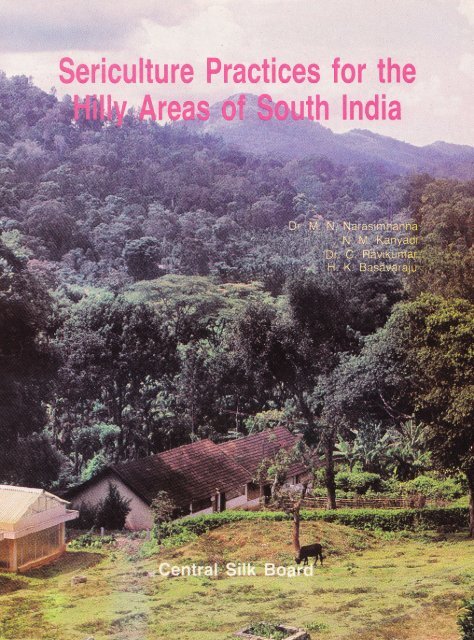

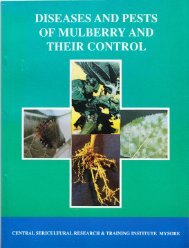

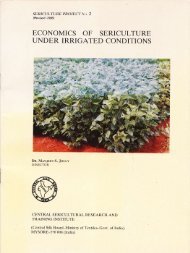
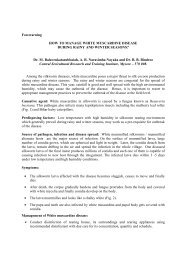
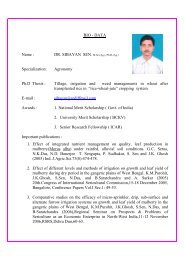
![E}A]\GALORE](https://img.yumpu.com/54052619/1/190x260/eagalore.jpg?quality=85)
